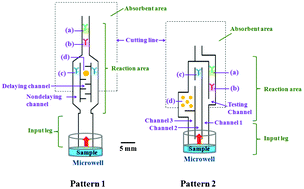Development of automated paper-based devices for sequential multistep sandwich enzyme-linked immunosorbent assays using inkjet printing†
Abstract
To the best of our knowledge, this is the first report on paper-based devices for automating the sequential multistep procedures of a sandwich-type enzyme-linked immunosorbent assay (ELISA) that require only a single-step application of the sample solution. The device was based on a piece of nitrocellulose (NC) membrane with specially designed channels, where all the reagents are applied at different locations in order to control the fluid travel to the detection region. The inkjet printing method, a simple and low-cost process, was used to create the flow channel and device barrier patterns. The fabricated barrier was found to be an efficient boundary for the liquid along the printed design in the NC membrane, enabling direct control of the reagent flow time. ELISA results were obtained with a single-step sample application. The developed devices (so-called automated paper-based devices) provided a simple procedure for the sandwich ELISA, while reducing assay time and reagent consumption. Colorimetric results were measured using digital camera imaging with software processing. The capability of the method developed herein was successfully used to determine the levels of human chorionic gonadotropin (hCG) by ELISA.


 Please wait while we load your content...
Please wait while we load your content...